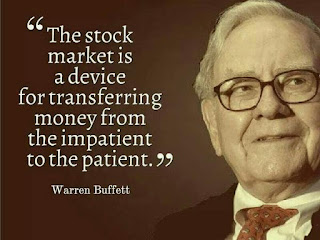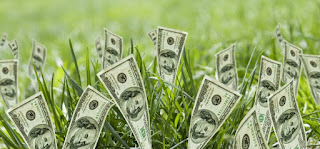 |
| Dividend Stocks |
1) Losses Mitigation: Dividend payouts can offset losses in market
value.
If a non-dividend paying stock purchased at $100 loses 10%
of its value, it will be worth only $90.
However, if a dividend paying stock bought at $100 and providing
a $4 annual dividend (4%), loses 10% of its value it will drop to $90. But as long as the dividend doesn’t get cut, it
pays $4 which, if automatically reinvested, yields $94 worth of stock: the
original $90 + $4 dividend reinvested.
The $4 advantage of the dividend payer ($94) doesn’t seem
like much but represents a 4.4% premium to the non-dividend paying stock ($90). If you multiply that difference over
thousands of shares accumulated during an investing career, the delta is substantial. For example, the $40,000 difference between
having $900,000 at retirement vs $940,000 may be nearly a full year’s income
for some investors.
2) Principal Protection I: The second reason div
stocks are superior to non-div stocks is because they provide a level of
principal protection unavailable with non-dividend payers.
Dividend
paying stocks generate income without selling off the principle. If
an investor with a non-dividend stock portfolio of $1,000,000 needs $40,000 in
income she has to sell $40,000 from her portfolio to meet her needs leaving her
with $960,000. Consequently, her principal or nest egg diminishes over
time. In this condition, her best hope is that market value appreciation
offsets the value of the stock she sold. However, counting on Mr. Market
to move ever upward over short investment horizons is a questionable
bet.
On
the other hand, a dividend paying portfolio of $1,000,000 delivering a 4% yield
generates income of $40,000 without selling any of the
principal. The investor receives her income and still has her
$1,000,000 vs the $960,000 she would have had with the non-dividend paying
stocks. Her nest egg remains fairly constant relative to the diminishing
next egg she would have to work with otherwise.
Of course, taxes will alter the
figures above to some extent, but the principal protection advantage of
dividend paying stocks remains unchanged.
3) Principal Protection II: The advantage of dividend paying stocks
becomes greater during periods of bear markets.
If a bear market hits, when our investor from the previous post has to
sell her shares to generate a $40,000 income, she will have to sell more shares
at a lower price to meet her needs than she would if the share price remained
constant.
In a market in which her shares do not decline in value, she
would have to sell 400 shares at $100 each to generate $40,000 in income.
However, during a bear market in which her share price drops
to $80, for instance, selling 400 shares results in only $32,000 in
income. To reach $40,000, she has to
sell an additional 100 shares generating $8,000 to get to her required income. As a result of the market downturn she now
has to sell 500 shares at $80 each to equal what she would have received for
400 shares at $100 each.
As a result of this math, she has 100 fewer shares than
anticipated meaning any rebound in stock price has to account for the original
loss in value plus the value of the additional shares she had to sell just to
get back to even.
Conversely, if a dividend paying portfolio experiences a
bear market, and the dividend remains constant, the value of the portfolio may
decline, but the dividend payments do not.
Consequently, the dividend portfolio investor doesn’t have to recover
the value of share sold nor replace the value of additional shares sold due to the
lower price.
In short, not only do you benefit from the principal protection of dividend payments by not having to sell shares, but you don’t
have to suffer the added “bonus” of selling more shares than you planned to
because of an unexpected decline in market value.
4) Cash Flow: Dividend paying stocks provide a stream of
cash that doesn’t depend upon selling any of the principle. The cash flow is generally regular and
predictable – especially when invested in companies with long records (15-25+
years) of uninterrupted dividend payments.
This means it’s possible to think of a dividend stream like a second
job… without actually going to work. The
technical term for this is, “wake up money”.
You wake up in the morning and collect the dividends. With that said, the dividend income stream is
not guaranteed… then again, neither is a second job.
5) Pay Raises: Investing in stocks providing regular
dividend increases makes it possible to watch your income grow. Without going to work, improving your performance,
or taking on a second job, dividend payers that increase their payouts serve up
nearly annual pay raises. Although the
raises from dividend increases aren’t always large, they do compound. Non-dividend paying stocks don’t offer the
same benefit.
6) Power of Compounding: Albert Einstein is to have said compound
interest is the 8th wonder of the world. Whether or not that statement is accurate is
debatable. However, compound interest is
still a powerful financial mechanism.
Dividend paying stocks held in Dividend Reinvestment Plans (DRIP) allow
investors to make regular (monthly or quarterly) additions to a stock portfolio
allowing those additions to compound over time.
Non-dividend paying stocks can realize some level of
compounding but the fact that investments of this nature are not always regular
nor as frequent as a DRIP means the effect of compounding for these stocks lags
that of regular dividend reinvestments.
Compounding is more effective through quarterly dividend reinvestment rather
than done once or twice a year. The more
compounding periods you have for a given amount of money, the stronger the
compounding effect. It’s simply math.
Regular dividend reinvestments represent a
dollar-cost-averaging method of investing versus the market timing approach
used in trying to determine the “best” window in which to invest. The dollar-cost-averaging approach generally
ensures some shares are acquired at lower prices resulting in a stronger
compounding effect since more shares are purchased for a given level of dividend
distribution. Investors who add cash at
irregular intervals may aren’t able to take full advantage of
dollar-cost-averaging.
Transactions costs (see the next point) associated with
stock purchases further reduce the effect of compounding over time.
7) No Transactions
Costs: Dividend paying stocks held
in dividend reinvestment plans (DRIP) generally allow you to automatically
invest dividends without incurring transaction costs. A stock valued at $100 dollars paying a $4
dividend reinvested through the DRIP means that $4 of new stock is purchased
each year while avoiding a brokerage fee for making that investment. As I said, this is generally true, but there are
exceptions so pay attention to the rules of the DRIP.
The only way to regularly add to a non-dividend paying holding
is by purchasing additional shares through a broker and paying the associated
brokerage fees for conducting the transaction.
Siphoning off only a few dollars per transaction adds up with time and frequency
diminishing compounding benefits noted previously.
8) Better Performance: Given the advantages outlined, it’s not
surprising dividend paying stocks perform well.
In fact, dividend
payers outperform their non-dividend paying brethren over time. Moreover, stocks that regularly increase
dividend payments perform even better than those which simply maintain a
constant rate. Dividend payers not only
outperform their non-dividend paying cousins, but they do so with less
volatility allowing you to sleep better at night. Who doesn’t like a great night’s sleep with
solid “wake up money” in the morning?
The thoughts and opinions expressed here are
those of the author, who is not a financial professional, and should
not be considered as investment advice.
The information is presented for consideration and entertainment only. For specific investment advice or
assistance, please contact a registered investment advisor, licensed broker, or
other financial professional.




